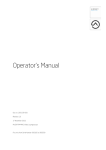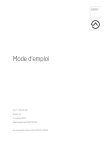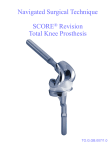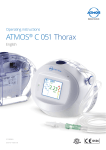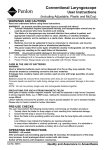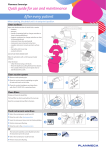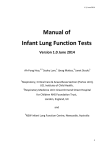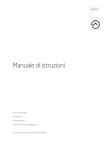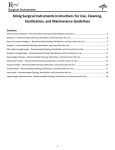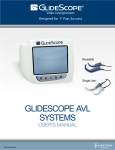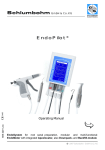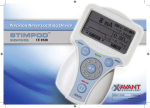Download Operator`s Manual
Transcript
McGRATH ® Video Laryngoscope Series 5 HLDi Operator’s Manual Doc No: 505-100-008 Revision 1.1 21st August 2009 McGRATH® Video Laryngoscope Series 5 HLDi Operator’s Manual Revision 1.1 21st August 2009 Document Number 505-100-008 Contents 1 Introduction 2 1.1 Description 2 1.2 Accessories and Part Numbers 2 1.3 Specifications 3 1.4 Regulatory 3 2 Functional 4 2.1 Unpacking and Inspection 4 2.2 Batteries 5 2.3 Fitting the Battery 5 2.4 Fitting the CameraStick™ 6 2.5 Blade Fitting 7 2.6 Blade and Monitor Adjustment 8 2.7 Standby - Switching On / Off 2.8 Using the Laryngoscope 10 3 Cleaning and Decontamination 11 3.1 Decontamination of McGRATH® Series 5 HLDi Devices 11 3.2 Disinfection 14 3.3 Drying and Storage 15 3.4 Sterilization 16 3.5 Disposal of Intubation Blades 16 3.6 Handling and Product Preservation 16 3.7 Environmental 16 4 Maintenance 17 5 Troubleshooting, Replacement Parts & Repair 18 6 Warranty 20 9 1 Introduction 1.1 Description 1.3 Laryngoscope Assembly Size 200mm x 50mm x 150mm Weight 0.28kg Power AA 1.5V Battery For information regarding battery life, refer to section 2.2 of this manual Light source High intensity LED fibre Display Colour LCD (1.7” diagonal) Camera VGA Protection IPx7 Materials Durable medical grade rubber, thermoplastics and stainless steel This device and packaging are latex free The McGRATH® Series 5 HLDi Video Laryngoscope (“the McGRATH®”) is a device designed to aid the intubation of the trachea. A rigid laryngoscope blade restrains the tongue, allowing a clear view of the larynx and entrance to the trachea. The need to provide a guaranteed airway is fundamental to an anaesthesiologist’s task prior to an operation. Paramedics, Emergency Department Consultants and General Practitioners may also be required to insert a tracheal tube to keep the airway open in an unconscious patient. The McGRATH® incorporates a light source and miniature camera within the CameraStick™ assembly to view the larynx during the procedure of intubation. The image is displayed on an LCD screen mounted to the handle of the device. Disposable Intubation Blade Size 110mm x 12mm x 15mm Material Medical grade optical polymer Packaging Packaged sterile for single use only This device and packaging are latex free A single AA 1.5V battery mounted within the handle powers the camera, display and light. The disposable sterile blade covers the CameraStick™/light assembly. 1.2 Accessories and Part Numbers UNDER NO CIRCUMSTANCES SHOULD ANY OTHER TYPE OF LARYNGOSCOPE BLADE BE USED WITH THIS MEDICAL DEVICE DO NOT OPEN ANY SEALED PART OF THE DEVICE UNDER ANY CIRCUMSTANCES.TO DO SO WILL IMPAIR THE PERFORMANCE OF THE DEVICE AND PATIENT SAFETY AND INVALIDATE THE WARRANTY The McGRATH® is not supplied with batteries or with disposable intubation blades – blades should be purchased separately from your distributor or agent. McGRATH® Intubation Blades (Carton of 30) 550-006-000 McGRATH® Series 5 HLDi Video Laryngoscope 505-000-000 McGRATH® Maintenance Kit 500-070-005 McGRATH® Video Laryngoscope Series 5 HLDi Specifications 1.4 Regulatory This product complies with EN 60601-1 and EN 60601-1-2 safety standards. The CE mark indicates that it meets the requirements of European Council Directive 93/42/EEC concerning medical devices. Aircraft Medical Limited operates an approved Quality Management System in accordance with BS EN ISO 13485. “McGrath” is a registered trademark of Aircraft Medical Limited. “Aircraft” is a registered trademark of Aircraft Medical Limited. “CameraStick” is a trademark of Aircraft Medical Limited. Only personnel trained in and licensed to perform intubation with a laryngoscope may use this device. Operator’s Manual Revision 1.1 21st August 2009 The user must contact the distributor to arrange responsible disposal and compliance with Waste Electrical and Electronic Equipment regulations as locally applicable, and any similar future environmental regulation applicable (including but not limited to Directives 2002/95/EC and 2002/96/EC as implemented in the Territory). Document Number 505-100-008 CAUTION : FEDERAL (USA) LAW RESTRICTS THIS DEVICE TO SALE BY OR ON THE ORDER OF A LICENSED PRACTITIONER 2 3 2 Functional 2.1 Unpacking and Inspection 2.2 The device is powered by a single AA battery. For safety reasons, the batteries are not supplied with the unit. The McGRATH® will accept any AA battery. The McGRATH® will give longer use with lithium batteries. We do not recommend the use of Zinc Chloride batteries due to limited life. Unpack the McGRATH® and check for any visible signs of damage that may have occurred during shipment. In the event of signs of damage do not use the laryngoscope, and inform your local agent or distributor. The packaging should contain the following items: CameraStick™ Module Batteries TIME Up to 3 hours Handle Module Up to 3 hours Up to 2.25 hours Up to 1.5 hours Up to 0.75 hours 0 hours Lithium 2.3 The McGRATH® is supplied in a non-sterile state. It will be necessary to decontaminate the laryngoscope according to local requirements before use on a patient. (See section 3.1) Nickel Metal Hydride (NiMH rechargeable, 2700 mA-h) Alkaline Unbranded Zinc Chloride Fitting the battery Unscrew the Top Cap as per the diagram below and insert battery with positive terminal upwards. Replace Top Cap. The laryngoscope blade (purchased separately) is supplied in a sterile state. Ensure that handling precautions are taken in accordance with local, national and harmonised standards. McGRATH® Video Laryngoscope Series 5 HLDi Operator’s Manual Revision 1.1 21st August 2009 Document Number 505-100-008 4 5 2.4 2.5 Fitting the CameraStick™ Blade Fitting Remove the protective labels from the contact strips on the rear of the CameraStick™ and from the end of the CameraStick™. The McGRATH® is designed to be used only with McGRATH® Disposable Intubation Blades. Release the safety catch by pulling out and rotating, then slide the CameraStick™ into the clamp at the bottom of the handle module. Return the safety catch to the upright position. It should be possible to hear the ratchet tooth ‘clicking’as the CameraStick™ passes through the clamp. These blades are packaged and supplied sterile and MUST be disposed of after each patient use. Ensure that the CameraStick™ slides smoothly through the clamp whilst still requiring a reasonable amount of force to deflect the ratchet tooth. FAILURE TO RELEASE THE SAFETY CATCH WHEN FITTING THE CAMERASTICK™ WILL LEAD TO DAMAGE TO THE HANDLE To fit the blade, remove the blade from sterile packaging and slide over the CameraStick™. The blade is fully located when the blade clip is firmly latched to the CameraStick™. Safety catch rotated Safety catch ENSURE THAT LOCAL HANDLING PROCEDURES ARE FOLLOWED AT ALL TIMES WHILST HANDLING STERILE DEVICES CHECK THAT THE BLADE IS CORRECTLY FITTED TO THE CAMERASTICK™ BEFORE USING ON A PATIENT McGRATH® Video Laryngoscope Series 5 HLDi Operator’s Manual Revision 1.1 21st August 2009 McGRATH® BLADES MUST ONLY TO BE USED WITH A McGRATH® SERIES 5 VIDEO LARYNGOSCOPE. DO NOT ATTEMPT TO USE ANY OTHER LARYNGOSCOPE BLADE WITH THIS EQUIPMENT IF THERE IS ANY EVIDENCE THAT THE STERILE BARRIER ON THE BLADE PACKAGING HAS BEEN BREACHED, DO NOT USE THE BLADE DO NOT PUT LIQUID ON THE CAMERASTICK™ OR ON INTERNAL SURFACES OF THE BLADE Document Number 505-100-008 6 7 2.6 2.7 Blade and Monitor Adjustment The length of the CameraStick™ may be adjusted for operation by sliding laterally through the clamp. The ratchet tooth grips the blade at 3 different length settings. STANDBY - Switching on / off The Laryngoscope is switched on by pushing the STANDBY button.The LED on the monitor will light up to show that power is applied to the system. Switch the equipment to standby by pushing the STANDBY button. Ensure that the equipment is always switched to standby after use to preserve the charge in the battery. When the unit is switched on, the device automatically checks the charge state of the battery. If the battery has sufficient charge to operate, the LED on the monitor illuminates continuously. When the device battery requires to be changed, the LED will begin to flash to indicate that the battery charge is low. When this occurs, it is recommended that the battery is changed IMMEDIATELY, as the device will only remain operational for a short period of time in this condition. LED on - battery OK LED flashing - check battery The monitor may be rotated in a horizontal and vertical plane for best viewing angle. 135 degrees 90 degrees McGRATH® Video Laryngoscope Series 5 HLDi Operator’s Manual Revision 1.1 21st August 2009 Document Number 505-100-008 8 THE MONITOR HAS POSITION STOPS AT THE ENDS OF ITS TRAVEL. DO NOT FORCE THE MONITOR BEYOND THESE POINTS 9 2.8 Using the Laryngoscope The laryngoscope should be turned on as detailed in section 2.7. A bright light should appear at the tip of the CameraStick™, and an image on the screen at the top of the handle. 3 Cleaning and Decontamination 3.1 Decontamination of McGRATH® Series 5 HLDi Devices WARNING: DO NOT AUTOCLAVE THIS DEVICE WARNING: ENSURE THE DEVICE IS COMPLETELY DRY BEFORE USE Anesthesia should be induced according to the anesthesiologist’s preference. WARNING: ALWAYS ENSURE THE BATTERY IS REMOVED BEFORE DECONTAMINATION The tip of the laryngoscope blade should be inserted into the mouth in the midline, superior to the tongue, and rotated towards the larynx in a sagittal plane until the epiglottis is visible. Either direct vision, along the superior surface of the blade, or indirect vision via the camera, can be used to guide the laryngoscope tip toward the larynx. Care should be taken, as with conventional laryngoscopy, that the blade does not make contact with the teeth. WARNING: THIS DEVICE SHOULD NOT UNDERGO DECONTAMINATION OR DRYING PROCESSES ABOVE 60°C WARNING: IT IS THE RESPONSIBILITY OF THE USER TO ENSURE THAT THE CLEANING PROCESS, AS IT IS ACTUALLY PERFORMED, ACHIEVES THE DESIRED RESULT The tip of the blade should be guided into the vallecula. Further rotation, and/or minimal force applied along the long axis of the handle, should lift the epiglottis and allow a view of the glottis. Again, either direct or indirect vision can be used to view the glottis. Once the glottic opening has been correctly identified, a correctly sized tracheal tube can be passed between the vocal cords. A bougie or a malleable introducer may be used to assist the passage of the tracheal tube. If a malleable introducer is used, we recommend that a “hockey stick”curve be made at a point about 5cm from the tip of the tracheal tube. The laryngoscope can then be carefully withdrawn by reversing the process described above. Confirmation of the correct placement of the tracheal tube should be both visual, and by the use of capnography. WARNING: AFTER ANY CLEANING / DISINFECTION / STERILIZATION PROCESS ENSURE THAT THE DEVICE HAS NO DAMAGE OR LOOSE PARTS AND OPERATES CORRECTLY WARNING: ANY TRAYS OR CONTAINERS THAT ARE USED IN ANY OF THE PROCESSES BELOW SHOULD BE INSPECTED FOR VISIBLE SOIL AND MUST BE CLEANED BEFORE USE WARNING: CHEMICALS AND EQUIPMENT RECOMMENDED IN THIS DOCUMENT MUST BE USED IN ACCORDANCE WITH THE MANUFACTURER’S INSTRUCTIONS FOR USE AND LOCAL HANDLING PROCEDURES These instruction have been prepared to provide decontamination and sterilization instructions for the McGRATH® Series 5 HLDi Video Laryngoscope. These methods were developed using standard equipment and practices common to global healthcare facilities, using the guidance given in AAMI TIR 12 (Designing, Testing, Labelling Reusable Medical Devices for Reprocessing in Health Care Facilities: A Guide for Device Manufacturers) and ISO 17664:2004 (Sterilization of medical devices Information to be provided by the manufacturer for the processing of resterilisable medical devices). McGRATH® Video Laryngoscope Series 5 HLDi Operator’s Manual Revision 1.1 21st August 2009 Document Number 505-100-008 10 3.1.1 The device should be decontaminated after each patient use. 3.1.2 Dispose of all chemicals used in accordance with manufacturer’s guidelines. 3.1.3 General Information for Disinfection and Sterilization of Medical Devices Thorough cleaning and rinsing are vital for the decontamination of the product. The purpose of cleaning and rinsing is to remove all visible soil and to reduce the number of particulates, microorganisms, and pyrogens. Thorough rinsing is important for removing any residual cleaning agents from the medical devices. The decontamination methods have been validated by Aircraft Medical together with external, independent experts and companies. Other decontamination methods may be suitable but must be validated by the user of the device before use. 11 3.1.4 Before Cleaning • Remove battery and replace Top Cap. If Visible Soiling is present • • Immerse both parts of the device for a minimum of five (5) minutes in enzymatic detergent Use cleaning brushes to remove additional soil as necessary, taking care not to scratch optical surfaces • • • • Scrub crevices and around hinged/mating surfaces with a brush Rinse thoroughly with warm water Check instruments for visible soil. Repeat cleaning if soil is visible If the soiling persists the device may be immersed in an ultrasonic bath for ten (10) minutes in a warm enzymatic detergent solution to help loosen any particulate • Separate the Handle and CameraStick™. Rotate safety catch so that it is in the out position to aid cleaning. Cleaning Procedure • • • • • 3.1.5 Immerse the cleaning cloth in the enzymatic detergent solution and wring thoroughly Wipe all surfaces thoroughly ensuring that detergent solution comes into contact with all surfaces Periodically rinse the cloth in clean water and repeat the above steps Surfaces should be carefully hand-dried using a cloth or industrial hot air dryer or placed into a drying cabinet Safely dispose of cleaning materials Manual Cleaning Cleaning Equipment required: • • Video Laryngoscope Series 5 HLDi • Operator’s Manual McGRATH® Revision 1.1 21st August 2009 Document Number 505-100-008 12 A warm water/detergent solution at correct dilution such as ENZOL® A clean, disposable, absorbent, non-shedding cloth for application of detergent solution A clean, disposable, absorbent, non-shedding cloth for wiping product (Aircraft Medical recommends the use of a ultra-absorbent microfiber cloth) WARNING: ALWAYS ENSURE THE BATTERY IS REMOVED BEFORE CLEANING 13 3.2 Disinfection Manual Disinfection Preparation for Disinfection • It is important that the battery is removed from the device, the Top Cap is replaced, the unit separated and adequate cleaning be performed prior to disinfection per the procedure detailed in this manual Disinfection • All irritant disinfectant residues should be removed before the item is reused and care should be taken when rinsing to ensure that items are not re-contaminated during this procedure. Receptacles and containers used to contain devices should be cleaned before use Disinfection Equipment required • • • • • • A receptacle (with a lid) which can be disinfected and with sufficient capacity to immerse the item fully A means to contain or extract any irritant vapours A solution of freshly prepared chemical disinfectant, at the manufacturer’s recommended concentration such as Cidex OPA A receptacle which can be sterilized or disinfected to contain rinse water Sterile clean water to rinse items after chemical disinfection A clean, disposable, absorbent, non-shedding cloth or mechanical drying facility (Aircraft Medical recommends the use of an ultra-absorbent microfiber cloth) Disinfection Procedure • • • • • • • • • 3.3 Liquid chemical disinfectants can be supplied ready to use or may require mixing with an activator. Alternatively it may need accurate dilution to an in-use strength as per the manufacturer’s instructions Ensure that the disinfectant receptacle is clean and dry Wearing appropriate personal protective equipment, to include impervious gown, Nitrile or Butyl gloves, face mask/shield or face shield, fill the receptacle with sufficient prepared disinfectant solution so as to ensure complete immersion of the item to be processed Carefully immerse the item in the solution in such a way as to displace any trapped air within the item; it is important to ensure that the solution reaches all surfaces Place the lid on the receptacle and leave for the recommended time. Follow manufacturer’s recommended soak times: Cidex OPA – 12 minutes @ 25°C Metricide OPA – 12 minutes @25°C Cidex Plus – 20 minutes @ 25°C Metricide – 45 minutes @ 25°C Cidex – 45 minutes @ 25°C Metricide 28 – 90 minutes @ 25°C Remove the item from the solution, drain into receptacle before transferring to clean rinse receptacle Rinse thoroughly with sterile water of suitable microbiological quality Remove item from rinse solution and drain Carefully hand-dry using clean, absorbent, non-shedding cloth or industrial hot air dryer or place into drying cabinet Drying and Storage The device must be completely dry before use. Aid drying by placing the handle, with the top removed on a drying spike so that the opening is facing downwards to aid drainage. Place the Top Cap and CameraStick™ on a drying tray so that they are suspended to aid drainage. A drying cabinet is suitable to aid drying time. McGRATH® Video Laryngoscope Series 5 HLDi Storage of the device once decontaminated Store the device in a clean container, covered to prevent airborne contamination. Operator’s Manual Revision 1.1 21st August 2009 Document Number 505-100-008 14 15 3.4 Sterilization 4 Preparation for Sterilization 4.1 • 3.4.1 3.4.2 Ethylene Oxide Sterilization • Sterilize as instructed in the STERRAD User Manual (the standard cycle contains no user variables) STERIS V-Pro® Sterilization • 3.5 The device is compatible with EtO sterilizing processes STERRAD 100®, 200®, NX® Sterilization • 3.4.3 It is important that the battery is removed from the device, the Top Cap is replaced, the unit disarticulated and adequate cleaning be performed prior to sterilization per the procedure detailed in this manual Sterilize as instructed in the STERIS V-Pro User Manual (the standard cycle contains no user variables) Disposal of Intubation Blades The intubation blade must be disposed of after each procedure. The blade must be disposed of in accordance with standard departmental practices. 3.6 Handling and Product Preservation Ensure that care is taken at all times while handling the device. If the device is dropped, it is recommended that you check for any visible signs of damage. If the device is showing no signs of damage but is not functioning refer to the Troubleshooting Section. It is also recommended that the battery is removed from the device and the device returned to its original packaging when not required for use. Avoid leaving unattended in situations where it may be misused or damaged. McGRATH® 3.7 Video Laryngoscope Series 5 HLDi Operator’s Manual Revision 1.1 21st August 2009 Document Number 505-100-008 16 Environmental Maintenance Inspection The device should be inspected at regular intervals for: • visible signs of external damage • scratches or defects on the lens of the CameraStick™ • signs of deterioration of the LCD display • build-up of material on contact strips on CameraStick™ and contact pin area of Handle 4.1.1 4.1.2 Product checks Additionally, at six month intervals the following should be checked by a qualified technician: • check for signs of oxidization on electrical contacts • perform the functional checks In the event of problems the device must be returned to the distributor for repair or exchange. Maintenance Kit Lens Cleaning Procedure Every few months, or if the image on the screen becomes blurred, cloudy or obstructed, clean the camera lens with a conical foam swab. (Dipping the swab in IPA will help shift stubborn dirt). Contact Cleaning Procedure Every few months, or if the image is flickering or the battery life is short, clean the electrical contact points with the cleaning solution sachets found in this kit, using a simple 2-step process. Firstly open the sachet marked “Cut & Polish” (1) and wipe down the contact points firmly. Then open the sachet marked “IPA” (2) and wipe down the contact points firmly. This will remove dirt and carbon build up on the product. The contact points are located: • • In the battery cap and in the handle The bottom, top and contact point side of the CameraStick™ For re-ordering Kit use Part Number: 500-070-005 Operating Conditions: Storage & Transport Conditions: • 10ºC to 40ºC ambient • 10ºC to 40ºC ambient • Relative Humidity 10% to 50% • Relative Humidity 10% to 90% • Atmospheric Pressure 700h Pa to 1060 hPa • Category 2 Pollution Degree 2 Decontamination and Drying Condition: • 60ºC Maximum 17 5 Troubleshooting, Replacement Parts & Repair Any other faults will require to be diagnosed by an authorised repair centre. The device must only be diagnosed, repaired and serviced by an official Aircraft Medical Limited distributor or agent. Distributor Contact Details: Poor picture quality The image displayed on the screen is blurred or fuzzy • Check for fogging on the intubation blade. Remove the blade and check that the image is clear and bright. If necessary wipe the camera lens at the end of the CameraStick™ as per maintenance kit instructions • Check that the CameraStick™ is fully inserted in the blade and that the blade has latched to the CameraStick™ • Clean the contact strips on the CameraStick™ and the contact pins on the handle clamp using Maintenance Kit The image on the screen flickers or has lines across it When switched on, there is no display on the screen. Is the battery charge LED illuminated? The LED is not illuminated • • • Check that the battery is inserted in the correct orientation. (refer to section 2.3) Replace battery Check for oxidization on the battery contacts and, if required, clean the contacts using Maintenance Kit LED Flashing The LED flashing indicates that the battery requires changing. • Change the battery • Check that the battery is fully charged • Remove battery and check battery for oxidization • Clean the contact strips on the CameraStick™ and the contact disc of the Top Cap using Maintenance Kit • Use of Pin Pusher • Push the contact pins in and out using the Pin Pusher, as shown, for 2-3 seconds • Push the ground contact pin using the teeth of the Pin Pusher. Slide in and out for 2-3 seconds • Push the ratchet mechanism using the Pin Pusher as lever on the clamp area for 2-3 seconds The LED is illuminated • Video Laryngoscope • Series 5 HLDi Operator’s Manual McGRATH® Revision 1.1 21st August 2009 Check the LEDs situated at the end of the CameraStick™ module. If these are not lit there may be oxidization of the CameraStick™ or CameraStick™ clamp contact strips / pins. Clean using Maintenance Kit The unit may be receiving no signal from the camera. This also may be caused by oxidization of the CameraStick™ or CameraStick™ clamp. Clean using Maintenance Kit If none of the above achieves positive results, return the unit to your local distributor or agent for repair. If none of the above achieves positive results, return the unit to your local dealer for repair. Loose or poorly fitting components If any components become loose, physically damaged or fit poorly, under no circumstances use the equipment and return the unit to your local distributor or agent for repair or replacement. Document Number 505-100-008 18 19 6 Warranty Aircraft Medical Limited warrants that the device supplied is, on leaving the factory, free from defects in materials or workmanship. This warranty is valid only if the product is supplied to the end user by an Aircraft approved distributor or agent and has been maintained in accordance with procedures documented in the Operator’s Manual. If failure occurs from manufacturing defects within 12 months of purchase, Aircraft Medical will repair or replace the defective item. McGRATH® Video Laryngoscope Series 5 HLDi Operator’s Manual Revision 1.1 21st August 2009 Document Number 505-100-008 20 21 McGRATH ® Video Laryngoscope Series 5 HLDi Operator’s Manual Designed & manufactured by: Aircraft Medical Ltd 10 Saint Andrew Square Edinburgh EH2 2AF United Kingdom Tel: +44 131 718 6042 Fax: +44 131 718 6100 www.aircraftmedical.com ‘McGrath’ and ‘Aircraft’ are registered trademarks of Aircraft Medical Ltd ‘CameraStick’ is a trademark of Aircraft Medical Ltd International patents pending. Copyright Aircraft Medical 2009. Doc No: 505-100-008 Revision 1.1 21st August 2009













